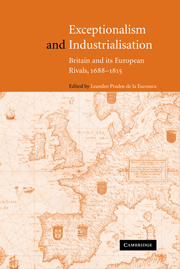Book contents
- Frontmatter
- Contents
- List of tables and figures
- List of contributors
- Acknowledgements
- Introduction: Was British industrialisation exceptional?
- Part I The origins of British primacy
- 1 Britain's economic ascendancy in a European context
- 2 Comparative patterns of colonial trade: Britain and its rivals
- Part II Agriculture and industrialisation
- Part III Technological change
- Part IV Institutions and growth
- Part V War and Hegemony
- Conclusions
- References
- Index
1 - Britain's economic ascendancy in a European context
Published online by Cambridge University Press: 04 December 2009
- Frontmatter
- Contents
- List of tables and figures
- List of contributors
- Acknowledgements
- Introduction: Was British industrialisation exceptional?
- Part I The origins of British primacy
- 1 Britain's economic ascendancy in a European context
- 2 Comparative patterns of colonial trade: Britain and its rivals
- Part II Agriculture and industrialisation
- Part III Technological change
- Part IV Institutions and growth
- Part V War and Hegemony
- Conclusions
- References
- Index
Summary
In 1815, Britain was the leading economy of Europe. The Industrial Revolution was two generations old, the breakthrough technologies in cotton, iron and steam were blossoming into large industries, more and more production was mechanised, urbanisation was far advanced, the railway was in sight. Britain's economic ascendancy was at hand.
It had not always been so. In 1500, Britain was a peripheral economy far from the economic core of Europe, which was still the Mediterranean. Most of the British population lived in the countryside, and most depended on agriculture. Productivity and incomes were low. Much of the rest of Europe was similarly backward. In the sixteenth and seventeenth centuries, the Dutch Republic pulled ahead and became the economic wonder of the age. British advance was slower but steady. By the seventeenth century, British incomes pushed past those of its chief continental rivals – France and the Habsburg Empire. By the eighteenth century, Britain extended its lead and overtook the Dutch. The Industrial Revolution was the capstone to this advance.
This book documents Britain's ascent in its many dimensions and examines the causal factors at work. These were both economic and political. Britain's economic progress cannot be separated from the establishment of her military hegemony. We begin by charting the dimensions of Britain's emergence as the leading economy.
Economic structure
Economic backwardness and advance show up dramatically in economic structure. Table 1.1 divides the population of the leading economies of Europe into three groups: agricultural, urban and rural non-agricultural.
- Type
- Chapter
- Information
- Exceptionalism and IndustrialisationBritain and its European Rivals, 1688–1815, pp. 15 - 34Publisher: Cambridge University PressPrint publication year: 2004
- 2
- Cited by

